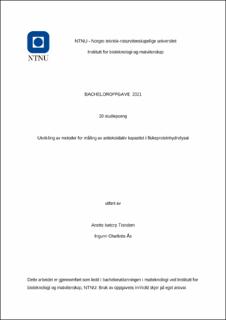| dc.description.abstract | Store mengder marint råstoff regnes i dag som svinn. Det er derfor interessant å se på hvilke antioksidative egenskaper ressursene har for å kunne benyttes i blant annet næringsmiddelindustrien i form av for eksempel tillaging av tran eller som tilsetninger. For å undersøke dette kan man benytte metoder som måler antioksidativ kapasitet. Målet med denne oppgaven var å utvikle og sammenligne metoder ved måling av antioksidativ aktivitet i to fiskeproteinhydrolysat av torskehode. Disse ble laget ved SINTEF Ocean i Trondheim i forbindelse med masteroppgaven «Marine Cod (Gadus morhua) Head Hydrolysates» skrevet av Margrethe Fossheim Ohnstad (Ohnstad, 2018). Fiskeproteinhydrolysatene ble analysert med metodene ABTS, DPPH og FRAP, og ble gjort for å forsøke å utvide standardkurvene til de ulike metodene. Analysen av hydrolysatene viste at de hadde en antioksidativ kapasitet på henholdsvis 20,31 µmol troloxekvivalenter/g for fiskeproteinhydrolysat 1 og 19,91 µmol troloxekvivalenter/g for fiskeproteinhydrolysat 2. Analyseringen av hydrolysatene var noe utfordrende da prøvene inneholdt mange partikler, som endret absorbansen i prøvene og lett sedimenterte til bunns. Sammenlignet med torskeolje og hvalolje ble fiskeproteinhydrolysatene vurdert til å være noe høyere enn disse. Dette er trolig som følge av at fiskeproteinhydrolysatene er ett mer sammensatt produkt, som inneholder større deler av det som gjør torsken antioksidativ.
FRAP ble funnet å ha stabilt reagens i ett døgn, og Trolox standarkurven kan brukes med verdiene 0 µM, 31,25 µM, 62,5 µM, 125 µM, 250 µM, 500 µM, 1000 µM og 1500µM.
ABTS ble vurdert til at ikke hadde stabilt nok reagens til at det bør stå over natten. Fra deg 1 til dag to endret absorbansen seg fra 0,788nm til 0,666nm, som i følge litteratur gjør at den kan brukes igjen, men dette bør analyseres videre. For standardkurven med propylgallat ble den vurdert som lineær og stabil med verdiene 10µM, 20µM, 30µM, 40µM, 50µM, 60µM og 70µM. For trolox standardkurven ble den vurdert som stabil sammen med ABTS med verdiene verdiene 0 µM, 31,25 µM, 62,5 µM, 125 µM, 250 µM, etter dette ble det en fullstendig reaksjon, som betyr at det er mer antioksidanter til stede enn ABTS reagenset kan måle. Felles for FRAP og ABTS analysen var at de begge holdt seg stabile over lengre inkuberingstid sammen med standardkurve, men når reagense reagerte lengre med fiskeproteinhydrolysatene så holdt ikke absorbansveriden seg stabil over tid. DPPH fikk ingen reaksjon med fiskeproteinhydrolysatet, trolig som følge av at hydrolysatet ikke var sterkt nok til å reagere med DPPH, eller at partiklene inneholdt antioksidantene, og at disse forsvant fordi ble filtrert vekk før analysen. | |
| dc.description.abstract | Large amounts of marine by-products are considered as waste. This makes it interesting to investigate the antioxidative properties of these resources so that they can be used in the food industry as for example preparation of fish oil or food additives. To determine the antioxidative capasity, different methods can be used. In this thesis, two different fish protein hydrolosates made from cod head are used. They were made by SINTEF Ocean in Trondheim in conjuction with the master thesis «Marine Cod (Gadus morhua) Head Hydrolysates» written by Margrethe Fossheim Ohnstad (Ohnstad, 2018).
The goal was to develop and compare methods of measurements of antioxidative activity in the two fish protein hydrolysates where the methods used were ABTS, DPPH and FRAP. This was done by trying to expand the standard curves in the different methods. The analyzes of the hydrolysates showed antioxidative capasity of respectively 20,31 µmol Trolox-equivalents/g in fish protein hydrolysate 1 and 19,91 µmol trolox-equivalents/g in fish protein hydrolysate 2. The analysis was a bit challenging as the samples contained a lot of particles, which had an impact on the absorbance and easily sedimented. The fish protein hydrolysates were considered to be a little higher compared with oil made from cod and whale. This is probably a result of fish protein hydrolysates being a more composite product containing bigger amounts of what makes the cod antioxidative.
FRAP were found to have a stable reagent after a day, and the Trolox standard curve can be used with the values 0 µM, 31,25 µM, 62,5 µM, 125 µM, 250 µM, 500 µM, 1000 µM and 1500µM. ABTS did not have a stable reagent after one day. The absorbance changed from 0,788 nm to 0,666 nm from the first to the second day, which in the theory makes it possible to use the reagent the next day, even though this should be analyzed further. The standard curve with propyl gallate was considered linear and stable with the values 0 µM, 31,25 µM, 62,5 µM, 125 µM and 250 µM. This made a complete reaction which shows that it was more antioxidants present than the ABTS-reagent is able to measure. Both the FRAP and ABTS analyzes retained stable with increased incubation time, while the absorbance did not keep stable over time when the fish protein hydrolysates reacted with the ragent. DPPH showed no reaction with the fish protein hydrolysate, most probably due to the hydrolysates not being strong enough to react with DPPH or due to some of the antioxidants remaining in the filter paper. | |
